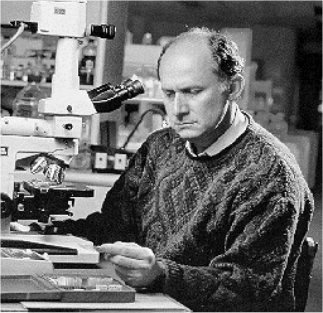 |
|||||||||||||||
Manuel E. Patarroyo |
|||||||||||||||
|
Doctor in Medicine and Surgery, Universidad Nacional de Colombia, Bogotá, Colombia, 1971. Fundación Instituto de Inmunología de Colombia (FIDIC) Bogotá, Colombia |
|||||||||||||||
 |
|||||||||||||||
"Transformations in making medical research non-profitable and available for marginalized poorer countries" |
|||||||||||||||
Biography |
|||||||||||||||
|
“ What other success could I claim better than that one? To have brought into this country a conciousness. So for the children, rather than being Maradonas or rock stars, no! They want to be scientists, and I think that is very important in our country [Colombia]”. Dr. Manuel E. Patarroyo is the first biochemist to develop the world’s first malaria vaccine: Spf66. While most scientists were trying to develop a vaccine to attack the sporozoite stage of the parasite, he targeted the merozoite form. The vaccine has been tested in 45 000 people and has an overall effectiveness rate of 31% to 60%. In spite of being offered $60 million by pharmaceuticals to buy the patent for his vaccine, Dr. Patarroyo donated the patent to the World Health Organization in 1995, thus to ensure a cheap and accessible cure for people in developing countries. In January 2001, a sudden collapse of his institute in Bogotá, raises a debt of $200 million to a Basque Bank that holds his research in standby just before a new human trial of an improved version of his vaccine was going to occur. Months later he founds a new institute with the support of the government and is able to force the Basque Bank to return his equipment with the help of Graca Machel, Nelson Mandela’s former wife, and Nobel prize-winning, Bruce Merrifield, and the circulation of a 10000-name petition. He is currently the head of the Colombian Immunology Foundation Institute (FIDIC). Dr. Manuel E. Patarroyo founded the Institute of Immunology in Bogotá in 1972, holds more than 21 honor doctorates from many universities around the world, and has received many prestigious awards including the “Prince of Asturias Prize”. “We’re marginalized. Latin America always has been distant from the fundamental concepts for developing science. We must learn to conceptualize science. That knowledge is constructed over centuries and it can’t be improvised”. |
|||||||||||||||
Selected Publications |
|||||||||||||||
| Troyeblomberg, M., Perlmann, H., Patarroyo, M. E. and Perlmann, P. (1983). Regulation of the Immune-Response in Plasmodium-Falciparum Malaria .2. Antigen Specific Proliferative Responses Invitro. Clinical and Experimental Immunology 53, 345-353. Wahlin, B., Wahlgren, M., Perlmann, H., Berzins, K., Bjorkman, A., Patarroyo, M. E. and Perlmann, P. (1984). Human-Antibodies to a Mr 155,000 Plasmodium-Falciparum Antigen Efficiently Inhibit Merozoite Invasion. Proceedings of the National Academy of Sciences of the United States of America-Biological Sciences 81, 7912-7916. Perlmann, H., Berzins, K., Wahlgren, M., Carlsson, J., Bjorkman, A., Patarroyo, M. E. and Perlmann, P. (1984). Antibodies in Malarial Sera to Parasite Antigens in the Membrane of Erythrocytes Infected with Early Asexual Stages of Plasmodium-Falciparum. Journal of Experimental Medicine 159, 1686-1704. Berzins, K., Perlmann, H., Wahlin, B., Carlsson, J., Wahlgren, M., Udomsangpetch, R., Bjorkman, A., Patarroyo, M. E. and Perlmann, P. (1986). Rabbit and Human-Antibodies to a Repeated Amino-Acid-Sequence of Plasmodium-Falciparum Antigen, Pf-155, React with the Native Protein and Inhibit Merozoite Invasion. Proceedings of the National Academy of Sciences of the United States of America 83, 1065-1069. Patarroyo, M. E., Romero, P., Torres, M. L., Clavijo, P., Moreno, A., Martinez, A., Rodriguez, R., Guzman, F. and Cabezas, E. (1987). Induction of Protective Immunity against Experimental-Infection with Malaria Using Synthetic Peptides. Nature 328, 629-632. Patarroyo, M. E., Amador, R., Clavijo, P., Moreno, A., Guzman, F., Romero, P., Tascon, R., Franco, A., Murillo, L. A., Ponton, G. et al. (1988). A Synthetic Vaccine Protects Humans against Challenge with Asexual Blood Stages of Plasmodium-Falciparum Malaria. Nature 332, 158-161. Rodriguez, R., Moreno, A., Guzman, F., Calvo, M. and Patarroyo, M. E. (1990). Studies in Owl Monkeys Leading to the Development of a Synthetic Vaccine against the Asexual Blood Stages of Plasmodium-Falciparum. American Journal of Tropical Medicine and Hygiene 43, 339-354. Amador, R., Moreno, A., Valero, V., Murillo, L., Mora, A. L., Rojas, M., Rocha, C., Salcedo, M., Guzman, F., Espejo, F. et al. (1992). The 1st Field Trials of the Chemically Synthesized Malaria Vaccine Spf66 - Safety, Immunogenicity and Protectivity. Vaccine 10, 179-184. Valero, M. V., Amador, L. R., Galindo, C., Figueroa, J., Bello, M. S., Murillo, L. A., Mora, A. L., Patarroyo, G., Rocha, C. L., Rojas, M. et al. (1993). Vaccination with Spf66, a Chemically Synthesized Vaccine, against Plasmodium-Falciparum Malaria in Colombia. Lancet 341, 705-710. Urquiza, M., Rodriguez, L. E., Suarez, J. E., Guzman, F., Ocampo, M., Curtidor, H., Segura, C., Trujillo, E. and Patarroyo, M. E. (1996). Identification of Plasmodium falciparum MSP-1 peptides able to bind to human red blood cells. Parasite Immunology 18, 515-526. Bastian, M., Lozano, J. M., Patarroyo, M. E., Pluschke, G. and Daubenberger, C. A. (2004). Characterization of a reduced peptide bond analogue of a promiscuous CD4 T cell epitope derived from the Plasmodium falciparum malaria vaccine candidate merozoite surface protein 1. Molecular Immunology 41, 775-784. Castillo, F., Guerrero, C., Trujillo, E., Delgado, G., Martinez, P., Salazar, L. M., Barato, P., Patarroyo, M. E. and Parra-Lopez, C. (2004). Identifying and structurally characterizing CD1b in Aotus nancymaae owl monkeys. Immunogenetics 56, 480-489. Lozano, J. M., Espejo, F., Ocampo, M., Salazar, L. M., Tovar, D., Barrera, N., Guzman, F. and Patarroyo, M. E. (2004). Mapping the anatomy of a Plasmodium falciparum MSP-1 epitope using pseudopeptide-induced mono- and polyclonal antibodies and CD and NMR conformation analysis. Journal of Structural Biology 148, 110-122. Bermudez, A., Alba, P., Espejo, F., Vargas, L. E., Parra, C., Rodriguez, R., Reyes, C. and Patarroyo, M. E. (2005). Fitting modified HRP-I peptide analogue 3D structure into HLA-DR molecules induces protection against Plasmodium falciparum malaria. International Journal of Biochemistry & Cell Biology 37, 336-349. |
|||||||||||||||
Linkss |
|||||||||||||||
| English: http://www.colombiaweek.org/20040913.html#culture http://www.guardian.co.uk/colombia/story/0,11502,630720,00.html Spanish: http://eltiempo.terra.com.co/cien/noticiascientificas/ARTICULO-WEB-_NOTA_INTERIOR-1829321.html http://www.banrep.gov.co/blaavirtual/credencial/113manuel.htm http://www.diariomedico.com/foros/080501.html http://www.banrep.gov.co/blaavirtual/letra-p2/paisqueduele/137.htm |
|||||||||||||||
 |
||||